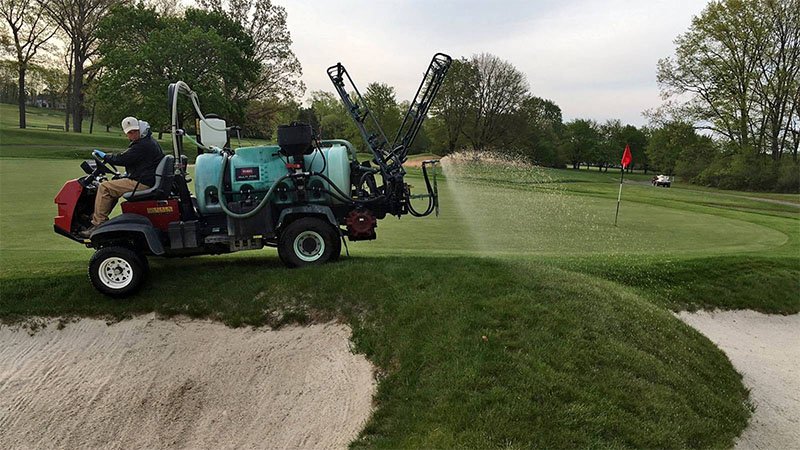
Opportunities often present themselves in the oddest of places, like on the first tee during a weather delay.
While sitting in the car waiting out a frost delay last December at Talamore Golf Resort in Southern Pines, North Carolina, Garrett Bastardi realized a moment of serendipity that would allow him to combine two of his passions - golf and forecasting the weather.
An aspiring tour pro who has been playing professionally for four years, Bastardi, 25, also is finishing his education at Penn State, where he is working toward a bachelor's degree in meteorology. Today, he is partnering with two other meteorologists as well as Herb Stevens, the golf-playing weatherman, on a short-range forecasting system called T3 that can help superintendents know when conditions will be right in a 48-hour window for a host of issues.
"I was playing between Christmas and New Year, and every day, there was a frost delay in the morning," Bastardi said. "There were 100 guys standing around waiting, and no one, not the starter or anyone in the golf shop, ever knew when we were going to be able to play. Being a meteorologist, I knew there were models to predict this."
 Stevens, known as the skiing weatherman, already has been offering his Grassroots Weather long-range forecasting platform to superintendents. Developed in part from World War II-era technology used by military meteorologists, Grassroots Weather has been providing superintendents with long-term weather trends for 18 years. Bastardi has been involved with Grassroots Weather for the past several years.
Stevens, known as the skiing weatherman, already has been offering his Grassroots Weather long-range forecasting platform to superintendents. Developed in part from World War II-era technology used by military meteorologists, Grassroots Weather has been providing superintendents with long-term weather trends for 18 years. Bastardi has been involved with Grassroots Weather for the past several years.
The T3 platform, which stands for Turf Threat Tracker, provides insight into several metrics on a micro level. Users enter their latitude and longitude (which can be easily determined through Google Maps) for precise two-day forecasts for issues such as ET, solar radiation, soil temperature, soil moisture, leaf wetness, frost, wind, visibility and lightning.
That information not only makes it easier to identify potential frost delays (and when they might be over), but also can help superintendent time spray applications and more.
"It gives me the ability to time operations, plant-protectant sprays or timing of a project on the golf course," said Rodney Hine, superintendent at Boston Golf Club in Hingham, Massachusetts.
"It has saved me when putting down an application that did not need water. If rain is in the forecast, I can change my schedule and get the product washed in."
Most forecasting models used in traditional platforms, such as The Weather Channel, are built on 18-mile-wide grids, meaning a forecast can be as much as 9 miles from your location. T3 is built on a tighter grid, ensuring a more accurate forecast.

"The big difference between this model and point-and-click models has to do with grid size," Stevens said.
"Our platform has a grid size of 1.8 miles, so your point of reference is never more than nine-tenths of a mile from the intersection where the forecast is produced for."
T3 has been in development since January. Several superintendents have been testing it and a few have liked enough of what they have seen to subscribe to the service. Thanks to a 28-day trial period, any superintendent can test it for free.
"I'm frustrated with weather forecasts," said Sam MacKenzie of Olympia Fields Country Club in Illinois. "The only person who can fail as much as a weatherman and more money are baseball players. You can hit .250 and still make a million dollars.
"No question, having an accurate forecast is important to have. I like the radar, but I'm still evaluating it. I do know already that there is a 90 percent chance of frost tomorrow."
"The big difference between this model and point-and-click models has to do with grid size..."
Also involved in the project are Steve Hallett and Andy Moffitt, fellow meteorology classmates of Bastardi's at Penn State.
"When superintendents have to make weather decisions on the fly, they might have to go to five or six sites to make a decision," Stevens said. "By the time they get to the fifth one, they've forgotten what the first one said.
"T3 is an all-in-one component where they get everything they need in one place. It contains tools they've never had at their disposal before."
Said Hine: "I'd like to be able to get back to focusing on the smaller details. The more efficiently I can do that, the more money I save. I like knowing what to expect. I learned a long time ago, you can't work against Mother Nature. You have to work with her. I've killed a lot of grass trying to work against Mother Nature."


